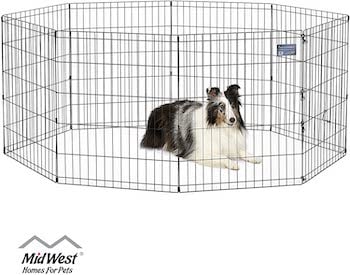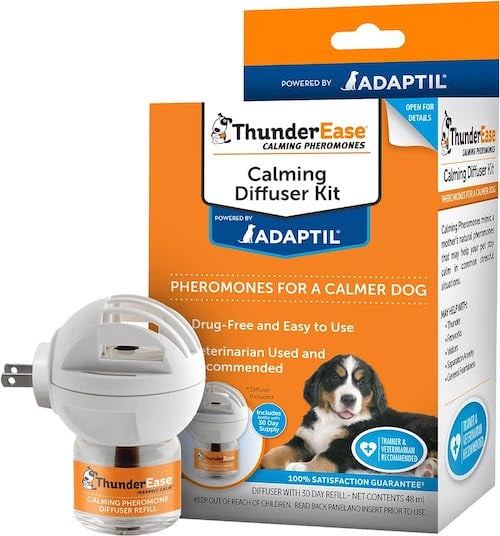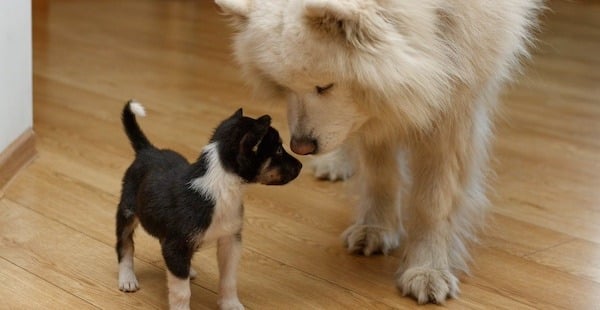If you are bringing home a new puppy from a breeder, ask them if you can bring your dog to meet the puppy in their space.
Your dog will need to be fully vaccinated, and your breeder may ask you to have your dog vaccinated beyond the basic core vaccines to protect their dogs and space, or they may decline this request. If so, you'll want to talk to them about your current dog's temperament and what the best match might be.
It's not abnormal for adult dogs to not enjoy puppies and need some time to adjust to their presence. They will need your help in providing breaks from the puppy. It's not your current dog's job to raise a new puppy for you.
Before the introduction, take each dog on a short walk or engage them in a light play session to release excess energy. A tired dog is less likely to be reactive or overexcited during introductions.
Off Leash Dog Introductions?
I much prefer off leash introductions between dogs because being on leash can increase tension. Without the option to add distance (flight), a leashed dog can resort more quickly with defensive aggression (fight) when they feel overwhelmed. You may have a leash reactive dog who barks and lunges on leash but does well interacting with dogs off leash.
If an off leash introduction would be best for your dog, I recommend hiring a certified dog trainer to help manage the introduction. In some cases, if you're adopting from a shelter, they will have an off leash play area for the dogs to meet, and will supervise the introduction with you.
Here are more tips for off leash introductions:
- The introduction location should be neutral and fully fenced. I highly recommend Sniff Spots for this.
- Have the dogs dragging leashes attached to harnesses, so there is an easy way to get a hold of each of them if needed.
- Ideally, start with one dog inside the area and allow them to sniff each other through the fence. Make sure there is no leash tension! Then call the dog inside away from the gate to allow the second dog to enter without a dog in their face.
- Keep the dogs moving by always moving yourself. You don't want them to congregate around you or in a corner and have a scuffle break out due to guarding or feeling stuck.
- Ensure the area is free of toys, food, or other resources dogs might guard. I do not recommend having treats with you for these introductions because they can trigger resource guarding behavior between unfamiliar dogs.

Parallel Walks for a Stress-Free Introduction
A great way to introduce dogs is through a parallel walk. Each dog should have their own handler and be on a leash (preferably a loose leash to avoid tension).
Start by walking at a distance where the dogs notice each other but remain relaxed. You can start with one dog farther ahead and another behind, and allow them to stop and smell where the other went potty to get scent information. Then switch who is ahead and who is behind. Another option is to be parallel across the street from each other.
Reward calm behavior with treats and praise. Gradually decrease the distance as they show positive interest without signs of fear or aggression. Allow them to sniff if both dogs appear comfortable, but keep the interaction brief and positive. The focus is on walking together, and movement helps prevent tensions from escalating.
Parallel walks are not recommended for dogs who exhibit leash reactivity.
If one dog becomes overly excited, increase the distance and slow the approach. Incorporate simple obedience cues like “sit” or “touch” to redirect their focus and reward them for calm engagement. I also recommend lots of "find it!" treat scatters (as long as there is no resource guarding history), as sniffing can be a calming activity.
Here's a great video showing parallel walks in action for introducing dogs:
The First In-Home Introduction
Once they’ve had a successful outdoor introduction, bring them inside together. Before doing so, remove high-value items like food bowls, favorite toys, and beds that could trigger resource guarding. Keep their first indoor interactions short and supervised. Use baby gates or leashes if needed to create controlled, safe interactions.
Keep leashes on but loose or dragging when indoors for initial meetings. This allows for easy intervention if needed while ensuring neither dog feels restricted.
 Use the Mr. Rogers Hack During Dog Introductions
Use the Mr. Rogers Hack During Dog Introductions
Practicing the Mr. Rogers Hack, a technique developed by ethologist Kim Brophey, is a great way to calmly narrate for your dogs what's happening and how they should feel about it. This is an especially helpful technique for puppies and helps keep you calm as well when you might be feeling a bit nervous about the interactions.
Download the Mr. Rogers Hack PDF to learn how to use this method.
Introducing a Puppy or Adolescent Dog to a Senior Dog
Introducing a younger dog to a senior requires extra patience and consideration. Older dogs may have less tolerance for energetic, playful behavior and may need more space and rest.
-
Provide separate resting areas: Ensure the senior dog has a quiet retreat where they won’t be disturbed.
-
Supervise play interactions: Puppies and adolescents often have boundless energy. Monitor interactions to prevent rough play that could stress or injure the senior dog.
-
Teach appropriate social behavior: Encourage the puppy to respect the senior dog's boundaries by redirecting overly boisterous behavior.
-
Use enrichment activities: Provide activities that engage the puppy without overwhelming the older dog, such as puzzle toys or scent games.
-
Consider mobility and health needs: Senior dogs may have arthritis or other medical issues that make prolonged interaction tiring. Allow them to set their own pace for engagement
Use the Karl Hack
When you have a young dog who wants to play non-stop, you need to satisfy their needs along with protecting your senior dog from pestering or rough play. The best way to do this is by signing your puppy up for well-run playgroup classes and using the Karl Hack at home.
This training hack uses a sturdy fake dog that your puppy can nip at and wrestle with in play, saving both you and your other dog from sharp puppy teeth and annoying play behaviors. You don't want something too floppy – get a life-size fake dog closest to your dog's size and breed that can stand up to getting thrown around and chewed on. Choose one in a standing position so it best replicates playing with another dog.
Here are a couple of options:
Ideally, bring out Karl preemptively, just before their usual crazy time. This often is in the evening. Use Karl to entice your puppy to play and let them beat up Karl as much as they want. Karl may need some stitches later on. You may stay involved with the play, moving Karl about to "interact" with your puppy, or allow your dog to just play with Karl on their own.
Once your puppy gets tired, then put Karl away until next time. Don't leave Karl out all day like a regular dog toy.
Click here to download the Karl Hack handout with more tips.
Here are a few photos from my clients of their puppies with their Karls after play. They tend to need a nap and will often drag Karl over to their bed to snuggle with:


Introducing a Dog to a Leash-Reactive Dog
If your resident dog is leash-reactive — barking, lunging, or growling at other dogs — you’ll need a careful approach and I highly recommend having the support of a certified dog trainer or behavior consultant during introductions. Many leash reactive dogs actually do just fine with dogs when off leash, which is why I recommend off-leash greetings rather than parallel walks on-leash.
-
Work on desensitization first: Before meeting the new dog, reinforce calm behavior when your current dog sees other dogs at a distance. Use treats and praise to create positive associations.
-
Off-leash introductions: See tips above for off leash introductions. It is best to have the support of a certified professional dog trainer during introductions between dogs when one or both has leash reactivity.
-
Use barriers: Baby gates or exercise pens can help with controlled sniffing sessions where dogs can interact safely without direct contact.
-
Monitor stress signals: If your leash-reactive dog begins to show signs of distress, increase distance and redirect their focus with training cues like “look at me” or treat scatter games (as long as there are no resource guarding tendencies).
-
Go at their pace: Some reactive dogs need weeks of gradual exposure before a face-to-face introduction. Let their comfort level guide the process.

Helping Your Dogs Get Comfortable With Each Other
Supervising Play and Setting Boundaries
Playtime should always be monitored initially. Look for reciprocal play, where both dogs take turns chasing and wrestling, rather than one dog constantly overwhelming the other.
If play gets too intense, calmly interrupt with a cue like name recognition and redirect their energy to a different activity.
Find in-depth tips for managing dog play here.
Feeding & Chew Time
When integrating a new dog into your home, I recommend keeping the dogs separate during meal times and edible chew "snack times." I actually prefer to keep dogs separated for meals long-term, as food bowls can be a very common trigger for fights to break out due to resource guarding.
If your first dog is free fed, it's best to get them on a regular meal schedule, rather than leaving food out all day. You won't be able to know which dog ate how much, which can result in overfeeding and/or underfeeding, along with making it hard for you to notice loss of appetite (a symptom of many medical issues). These are just some of the problems with free feeding.
For chew time, depending on how each dog acclimates to the other over time, you may be able to integrate them for future chew time together, but this shouldn't be a priority. It can be very good for both dogs to have their own alone time when working on a chew and when eating meals.

Play 14U-14U
To help your dogs learn to be in close proximity with each other and to prevent jealousy issues or pushy behavior, you can play the 14U-14U game.
When starting this game, it can be helpful to use a gate in between your dogs. Without a gate, I aim for having at least 3 to 4 feet of space between them, with my body in between. You say one dog's name and give them a treat, and then the second dog's name and give them a treat.
This can also be done without food, but using attention and petting as the reward. They are learning that the other receiving treats or attention predicts that they will get treats or attention – they just have to wait their turn.
If they get too close to each other, calmly help them move further apart or consider using an ex-pen or gate to increase separation for more practice. Here's a video of me playing this game with my two dogs, Fozzie and Sookie:
Maintaining Individual Attention and Training
Your current dog may need reassurance with all the changes and having to share your attention. Spend quality one-on-one time with each dog through training sessions, walks, and snuggle time. This helps prevent jealousy and strengthens their bond with you.
Rotate activities so each dog gets one-on-one attention without feeling left out. Training sessions with each dog separately can also reinforce positive behaviors, plus it's much easier to train one dog at a time. Once each dog has learned a skill, then start practicing with both dogs together.
When to Get Professional Help
If you encounter persistent conflicts between the dogs or are unsure about whether it's a good match, seek help from a certified dog trainer or canine behavior consultant. (Here's a list of what questions to ask a dog trainer to ensure they are qualified to help.)
If there are conflicts due to resource guarding, which is the most common type of aggression between dogs in the same household, connect with a certified canine behavior consultant. It's better to address potential issues as early as possible rather than wait to see if they "work it out."
Adjusting with Patience
It can take days, weeks, or even months for dogs to fully adjust to each other. Every dog’s personality is different, so allow the relationship to develop naturally at their own pace. And as each dog ages, their relationship can change, so always keep an eye on things to make sure they are still communicating well.
Have questions about introducing a new dog to your current dog? Let me know in the comments below!


 Bringing a new dog into your home is an exciting time, but if you already have a dog, a thoughtful introduction is key to setting both dogs up for success.
Bringing a new dog into your home is an exciting time, but if you already have a dog, a thoughtful introduction is key to setting both dogs up for success.


 Learning to identify subtle signs of stress, such as:
Learning to identify subtle signs of stress, such as:



